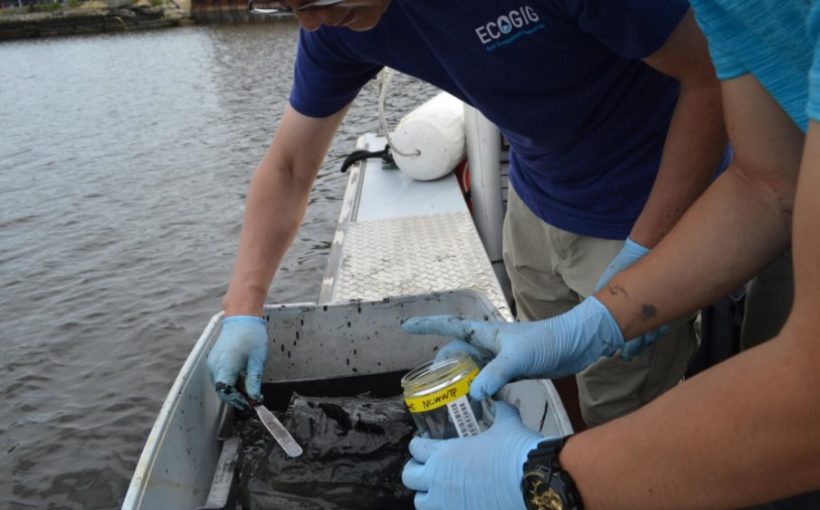
A new study shows that fecal bacteria from sewage are living in far greater quantities in near-shore sediments of the Hudson River than in the water itself. The river’s pollution levels are generally monitored based on samples of clear water, not sediments, so the findings suggest that people stirring up the bottom while wading, swimming or kayaking may face previously unrecognized health risks. Germs may persist for long periods or even reproduce in the sediments, say the authors. The study appears in the early online edition of the journal Science of the Total Environment.
The researchers sampled 11 sites along the river banks in suburban Rockland and Westchester counties, and in eastern Queens. In some, they found as much as 10 times more fecal bacteria in sediments as in overlying water. Water near the most polluted sediments tended to have elevated levels of bacteria and vice versa, suggesting an interchange between the two. Sites with sandier bottoms tended to have fewer germs, while levels were higher in fine, mucky organic-rich areas.
“These organisms originate in the human gut, where it’s organic rich and dark,” said Andrew Juhl, a biologist at Columbia University’s Lamont-Doherty Earth Observatory and coauthor of the study. “The water in the river is neither organic rich nor dark, but the sediments on the bottom typically are, and that makes them a better environment for potentially harmful microorganisms.” While the findings make common sense, it is one the first studies to test the idea in a river estuary, and is the first one in this region.
“This shows we have to think beyond just the [pollution] indicators we see in water,” said lead author Gregory O’Mullan, a microbiologist at Queens College and an adjunct at Lamont-Doherty.
A 2017 review of previous research coauthored by O’Mullan and Juhl says that, globally, human contact with polluted coastal waters causes more than 50 million severe respiratory infections and 120 million cases of gastrointestinal diseases, along with eye, ear and skin infections. In the United States, water at thousands of beaches is tested weekly during warm weather, and each year, high bacteria readings result in tens of thousands of beach-closure days. Some scientists have sampled beach sands and found high bacteria levels there as well, but such studies are still infrequent. “You have to think about this. I used to take my young daughter to the beach, and she didn’t get that much water in her mouth — but she was always covered with sand,” said O’Mullan.
O’Mullan and Juhl looked at two standard indicators of sewage contamination: the bacteria Enterococcus and Escherichia coli, which occur abundantly in the human gut. The bacteria can cause infections, but rarely serious ones; they are used instead as a proxy signal that less abundant but much more potent pathogens also excreted by humans also probably are present.
In the lower Hudson, most such germs probably get into the river from human sewage released through outfalls, leaks and overflows. Wildlife may play a smaller role, and in other systems farm runoff can also be an important source of bacteria. Many of these bacteria are not floating freely, but rather clinging to tiny particles of organic matter, said Juhl. In open, flowing water, pathogens are constantly washed downstream and diluted, and sunlight kills many within hours or days. However, depending on water flow, tides and topography, many particles may settle down and pile up in the cozier, more stable environment of the bottom. Here, bacteria or viruses could potentially persist for weeks or even months. Feeding off organic-rich muck, they may even reproduce, say Juhl and O’Mullan.
As part of the study, Juhl and an assistant waded into 8 to 10 inches of water in a few spots near Piermont, N.Y. in order to stir up near-shore sediments (They wore calf-high boots.) Then they took samples of the muddied water. As expected, lab analyses demonstrated that stirring up the sediments heightened bacterial levels in the water. “If bacteria are going from the water to the sediment, does it work the other way around?” said Juhl. “I think it does.” Piermont, with its fine, muddy bottom, showed some of the highest bacteria readings in both water and sediment, along with three sites around Queens’ Flushing Bay.
“Our data would suggest that there’s a health risk with people splashing around in the water and resuspending stuff from the bottom. But we’d have to say that at this point it’s hard to quantify,” said Juhl.
O’Mullan pointed out that some municipalities along the river stop chlorinating their sewage during cold weather, on the theory that no one is swimming nearby, and that pathogens will be long gone by the time the recreational season returns. “This suggests that might not be such a good idea,” he said. “Putting sewage into the sediments is like putting it into the refrigerator — it lasts a lot longer.”
The study was supported by the Hudson River Foundation, Riverkeeper and the U.S National Science Foundation.


